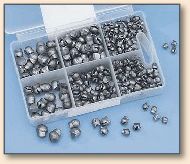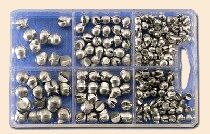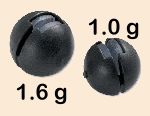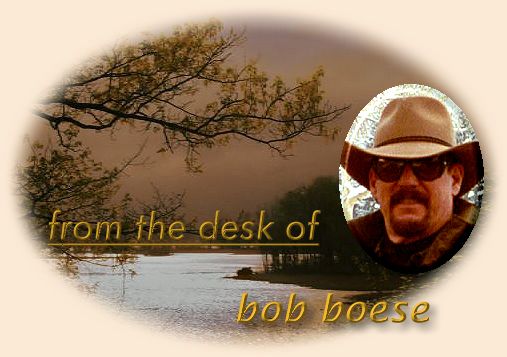Boudreaux's mother-in-law, Bertha, lives in Pensacola and is
five by five. She wanted to come visit and told Boudreaux
to get her a plane ticket, but get two seats because she didn't
fit in one.
"That will cost twice as much," Boudreaux said.
"Do it!" Bertha demanded.
As she was boarding the plane the stewardess said: "You don't
need two tickets, Mam."
"Oh, yes I do," Bertha insisted, "both seats are for me because
I don't fit in one."
"But," the stewardess answered, "one of these seats is row six
and the other is on fourteen."
Here is a weighty question: does your lead fly weight hurt the environment?
While wrapping lead wire around the hook shank of a soon-to-be nymph,
I recalled an article in my considerable stack of old fly fishing magazines.
This article discussed the hot topic argument over lead sinkers and the
environment. The article (August 1995 Fly Fisherman) noted
that the EPA made splashy headlines in 1994-5 with the release of data
that claimed thousands of tons of lead sinkers (about 500 million units) were
manufactured each year in the United States and released into the environment.
Huh? Yep, EPA assumed the sinkers were all released into the environment.
 The agency stated that lead sinkers, especially small split shot, would be
mistaken for gravel that birds swallow as grit to help them grind up and
digest food, and waterbirds, especially deep-diving birds such as loons,
would also swallow sinkers when eating fish who had escaped being caught
but still had attached lead fishing tackle. Okay, I know it sounds preposterous,
but this EPA document followed on the heels of the 1991 ban on lead shot
and subsequent Fish & Wildlife Service surveys that found a significant
reduction in lead poisoning in birds after the lead shot ban. In contrast,
the lead sinker scare was based on a 1992 study from Tufts University
regarding loon mortality in the northeast.
The agency stated that lead sinkers, especially small split shot, would be
mistaken for gravel that birds swallow as grit to help them grind up and
digest food, and waterbirds, especially deep-diving birds such as loons,
would also swallow sinkers when eating fish who had escaped being caught
but still had attached lead fishing tackle. Okay, I know it sounds preposterous,
but this EPA document followed on the heels of the 1991 ban on lead shot
and subsequent Fish & Wildlife Service surveys that found a significant
reduction in lead poisoning in birds after the lead shot ban. In contrast,
the lead sinker scare was based on a 1992 study from Tufts University
regarding loon mortality in the northeast.
So what happened to the proposed national lead sinker ban between 1995 and today?
First, consider that the 1992 Tufts study had limited data and geographic
restrictions. Then understand that a 1999 study by the Fish & Wildlife
Service found the Tufts' data "insufficient to evaluate" lead sinkers as being
a cause of bird mortality. Next realize that a single shell of banned lead bird
shot contains about 300 pellets that are never retrieved, while lead sinkers on
fly equipment are rarely lost. All of a sudden this begins to sound more anti-fishing
Peta-ish than logical. Nevertheless, several New England states have enacted
versions of lead sinker/jig bans, and the Defenders of Wildlife has even posted
a cut-and-paste version of ban legislation for other states to use
[https://www.serconline.org/lead/ban.html].
These states justified their legislation on the mortality of loons due to lead
poisoning, claiming that lead sinkers account for 30-50 %of adult
loon deaths. Okay, so what happened to the national lead
sinker ban?

Simply stated, the impact of lead fishing tackle has not been
documented or even well studied. Some claims suggest that
as much as 3,000 tons (yes, that's six million pounds) of lead
per year is lost in the waterways of the U.S. and Canada in the
form of sinkers. Essentially, the argument goes, sinker
manufacturers make that many pounds of sinkers each year
so fishermen must be purchasing them to replace lost sinkers.
Now if this were true it would mean that lead sinkers contribute
a number not that far below what was supposedly contributed by
lead shot.

Lost lead sinkers…but…wait.…there are no reported
cases of large-scale fish die-offs due to lead sinkers. Why not? Most
likely because it never happens. It seems that lead does not bioaccumulate
in the food chains of freshwater aquatic vertebrates — i.e., you don't find
progressively greater amounts of lead as you move up the predator
hierarchy due to big fish eating little fish. Such concentration of lead
as there is in fish seems to be more a function of lead discharges into
waterways than from sinkers, and what lead there is in fish concentrates
in hard tissues such as bone and teeth which pass through rather than
being absorbed by predators. Big fish don't get lead poisoning from little
fish and birds don't either. Nevertheless, the arguments continue that lead
is harmful to an enormous variety of wildlife, and lead fishing sinkers and
other lead tackle contribute significantly to the risk.
While you can still buy lead sinkers practically anywhere other than
New England, fly sinkers are now commonly made from an array of
alternative materials including tin, copper, bismuth, steel, brass, tungsten,
and ceramic. The cost for this political correctness is: (1) four to thirty
times as much expense for tin or tungsten compared to lead and (2) brittle
split shot that can't be reopened without splitting. Consider also that you
want your terminal fly tackle to be as unobtrusive as possible. The smaller
the size of the weight, the better. But atomic weight of lead is 207.2 while
tungsten is 183.85 and tin is 118.71. That means that your tin weight must
be almost twice as large as your lead weight. Tungsten is only 12%
larger but many times more expensive — if you can find them.
Will there be a national ban on sinkers? Hopefully not. Will lead sinkers
and wire become unavailable to the public. Who knows? Some laws are
like a drive-by shooting, you're not involved but you get hurt anyway. ~ Bob
About Bob:
Robert Lamar Boese has fly fished for five decades. He is an
environmental negotiator, attorney and educator who has provided
environmental legal services for more than thirty-three years including
active duty with the U.S. Coast Guard and Department of Justice. He is a
well known fly tyer with several unique patterns to his credit. He has
developed and authored federal and state regulatory programs
encompassing a broad spectrum of environmental disciplines, has
litigated environmental matters at all levels of the federal and state
court systems, and is a qualified expert for testimony in environmental
law. He has authored over 60 published text chapters, comments or
articles on environmental matters, is a member of the Colorado, District
of Columbia and Louisiana Bar Associations, and is a certified mediator.
In addition to his legal practice, Mr. Boese has been a high school
teacher, an associate professor of Environmental Law and Public Health,
has authored numerous fiction and sports publications, and is a softball
coach and nationally certified volleyball referee. He is the president
of the Acadiana Fly Rodders in Lafayette, Louisiana and editor of
Acadiana on the Fly. He has been married for thirty years and is the
father of two fly fishing girls (25 and 21). For additional information
contact: Boese Environmental Law, 103 Riviera Court, Broussard, LA 70518
or call 337.856.7890 or email coachbob@ymail.com.
|

 The agency stated that lead sinkers, especially small split shot, would be
mistaken for gravel that birds swallow as grit to help them grind up and
digest food, and waterbirds, especially deep-diving birds such as loons,
would also swallow sinkers when eating fish who had escaped being caught
but still had attached lead fishing tackle. Okay, I know it sounds preposterous,
but this EPA document followed on the heels of the 1991 ban on lead shot
and subsequent Fish & Wildlife Service surveys that found a significant
reduction in lead poisoning in birds after the lead shot ban. In contrast,
the lead sinker scare was based on a 1992 study from Tufts University
regarding loon mortality in the northeast.
The agency stated that lead sinkers, especially small split shot, would be
mistaken for gravel that birds swallow as grit to help them grind up and
digest food, and waterbirds, especially deep-diving birds such as loons,
would also swallow sinkers when eating fish who had escaped being caught
but still had attached lead fishing tackle. Okay, I know it sounds preposterous,
but this EPA document followed on the heels of the 1991 ban on lead shot
and subsequent Fish & Wildlife Service surveys that found a significant
reduction in lead poisoning in birds after the lead shot ban. In contrast,
the lead sinker scare was based on a 1992 study from Tufts University
regarding loon mortality in the northeast.

